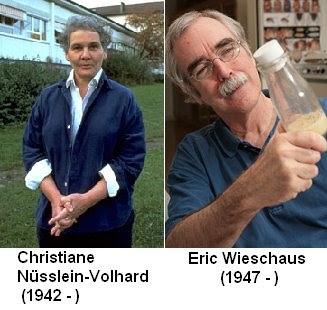
The 1995 laureates in physiology or medicine are developmental biologists who have discovered important genetic mechanisms which control early embryonic development. They have used the fruit fly, Drosophila melanogaster, as their experimental system. This organism is classical in genetics. The principles found in the fruit fly, apply also to higher organisms including man.
Using Drosophila Nüsslein-Volhard and Wieschaus were able to identify and classify a small number of genes that are of key importance in determining the body plan and the formation of body segments. Lewis investigated how genes could control the further development of individual body segments into specialized organs. He found that the genes were arranged in the same order on the chromosomes as the body segments they controlled. The first genes in a complex of developmental genes controlled the head region, genes in the middle controlled abdominal segments while the last genes controlled the posterior (“tail”) region. Together these three scientists have achieved a breakthrough that will help explain congenital malformations in man.
The fertilized egg is spherical. It divides rapidly to form 2, 4 , 8 cells and so on. Up until the 16-cell stage the early embryo is symmetrical and all cells are equal. Beyond this point, cells begin to specialize and the embryo becomes asymmetrical. Within a week it becomes clear what will form the head and tail regions and what will become the ventral and dorsal sides of the embryo. Somewhat later in development the body of the embryo forms segments and the position of the vertebral column is fixed. The individual segments undergo different development, depending on their position along the “head-tail” axis. Which genes control these events? How many are they? Do they cooperate or do they exert their controlling influence independently of each other?
This year’s laureates have answered several of these questions by identifying a series of important genes and how they function to control the formation of the body axis and body segments. They have also discovered genes that determine which organs that will form in individual segments. Although the fruit fly was used as an experimental system, the principles apply also to higher animals and man. Furthermore, genes analogous to those in the fruit fly have been found in man. An important conclusion is that basic genetic mechanisms controlling early development of multicellular organisms have been conserved during evolution for millions of years.
Credit : Nobel Prize
Picture Credit : Google




